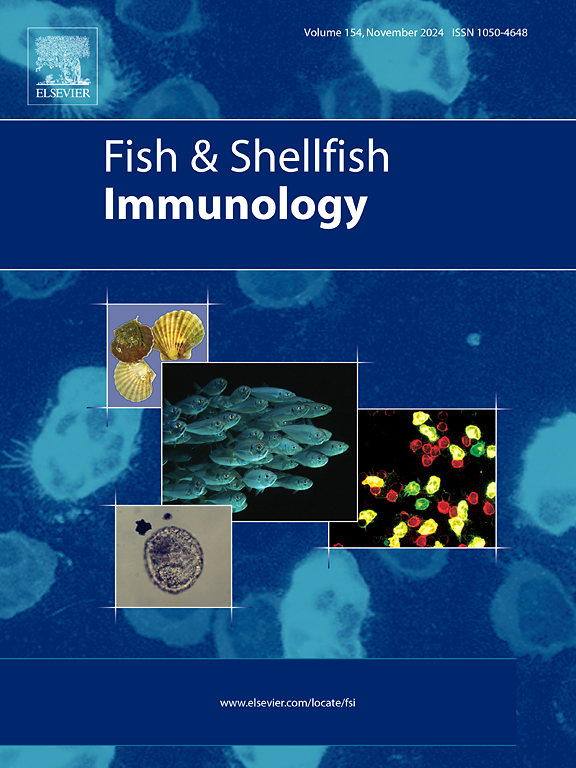橄榄鲽(Paralichthys olivaceus)肝脏表达的重组抗菌肽-2的抗菌活性
IF 4.1
2区 农林科学
Q1 FISHERIES
引用次数: 0
摘要
肝脏表达抗菌肽-2(LEAP-2)是一种富含半胱氨酸的多肽,在鱼类的先天免疫系统中发挥着重要作用。为了研究橄榄鲽(Paralichthys olivaceus)肝脏表达抗菌肽-2的分子功能,我们利用PCR技术克隆了编码LEAP-2的基因,并在大肠杆菌中进行了表达。对 LEAP-2 表达的分析表明,在感染水产致病菌 Edwadrsiella piscicida 的初期阶段,橄榄鲽肝脏中的转录本占优势,肠道中的水平较低,而肝脏和头部肾脏中的表达水平有所提高。超灵敏径向扩散试验表明,从大肠杆菌中纯化的重组 LEAP-2 (rOfLEAP-2) 对革兰氏阳性菌(枯草芽孢杆菌、副猪链球菌和花生乳球菌)和革兰氏阴性菌(哈维弧菌和大肠杆菌)均具有抗菌活性,最低抑菌浓度为 25 至 100 μg/mL 不等,具体取决于所测试的菌种。rOfLEAP-2的抗菌活性归因于其破坏细菌膜的能力,通过N-苯基萘-1-胺吸收测定和扫描电子显微镜分析验证了rOfLEAP-2对大肠杆菌、V. harveyi、B. subtilis和L. garvieae的作用。此外,当 rOfLEAP-2 与氨苄西林或合成 LEAP-1 肽结合使用时,抗菌活性会协同增强,这表明其作用机制与其他抗菌剂不同。这些发现为橄榄鲽中的 LEAP-2 的抗菌功效提供了证据,凸显了其对病原菌的潜在治疗用途。本文章由计算机程序翻译,如有差异,请以英文原文为准。
Antibacterial activity of recombinant liver-expressed antimicrobial peptide-2 derived from olive flounder, Paralichthys olivaceus
Liver-expressed antimicrobial peptide-2 (LEAP-2) is a cysteine-rich peptide that plays a crucial role in the innate immune system of fish. To investigate the molecular function of LEAP-2 from olive flounder, Paralichthys olivaceus, we cloned the gene encoding LEAP-2 using PCR and expressed it in Escherichia coli. Analysis of LEAP-2 expression revealed predominant transcripts in the liver and lower levels in the intestine of olive flounder, whereas their expression levels in the liver and head kidney increased, during the initial stage of infection with the aquapathogenic bacterium Edwardsiella piscicida. Recombinant LEAP-2 (rOfLEAP-2) purified from E. coli exhibited antimicrobial activity, as demonstrated by the ultrasensitive radial diffusion assay, against both Gram-positive (Bacillus subtilis, Streptococcus parauberis, and Lactococcus garvieae) and Gram-negative (Vibrio harveyi and E. coli) bacteria, with minimum inhibitory concentrations ranging from 25 to 100 μg/mL depending on the species tested. The antibacterial activity of rOfLEAP-2 was attributed to its ability to disrupt bacterial membranes, validated by the N-phenylnaphthalen-1-amine uptake assays and scanning electron microscope analysis against E. coli, V. harveyi, B. subtilis, and L. garvieae treated with rOfLEAP-2. Furthermore, a synergistic enhancement of antibacterial activity was observed when rOfLEAP-2 was combined with ampicillin or synthetic LEAP-1 peptide, suggesting a distinct mechanism of action from those of other antimicrobial agents. These findings provide evidence for the antibacterial efficacy of LEAP-2 from olive flounder, highlighting its potential therapeutic application against pathogenic bacteria.
求助全文
通过发布文献求助,成功后即可免费获取论文全文。
去求助
来源期刊

Fish & shellfish immunology
农林科学-海洋与淡水生物学
CiteScore
7.50
自引率
19.10%
发文量
750
审稿时长
68 days
期刊介绍:
Fish and Shellfish Immunology rapidly publishes high-quality, peer-refereed contributions in the expanding fields of fish and shellfish immunology. It presents studies on the basic mechanisms of both the specific and non-specific defense systems, the cells, tissues, and humoral factors involved, their dependence on environmental and intrinsic factors, response to pathogens, response to vaccination, and applied studies on the development of specific vaccines for use in the aquaculture industry.
 求助内容:
求助内容: 应助结果提醒方式:
应助结果提醒方式:


